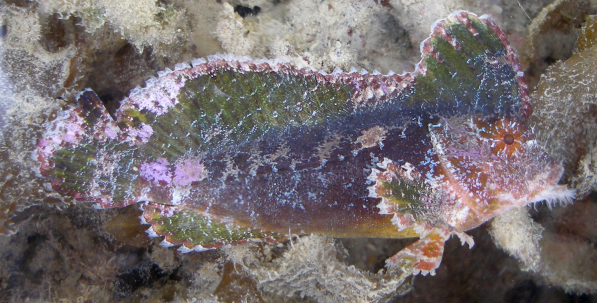Saltuarius eximius, A spectacular leaf-tailed gecko from Cape Melville, north-eastern Queensland.
Queensland Museums’s top 10 new species of the decade, Queensland Museum, 17 January 2020
Over the last decade our biodiversity team have been busy describing 1,171 new species. Here’s the top 10 species described by Queensland Museum scientists from 2010 – 2019.
Desis bobmarleyi

Desis bobmarleyi is a small spider with a 6mm long body and long hair like his namesake
It uses this long hair on its legs and abdomen to create an air bubble around its middle that enables it to breathe and survive between the high and low tide zones. During high tide these extremely rare and unusual animals hide in the air chambers, but during low tide they are vagrant hunters found on corals, barnacles or debris. It was this behaviour that inspired us to name this new intertidal species in honour of Bob Marley’s hit song High Tide or Low Tide, which played during our field research in Queensland’s Port Douglas.
Saltuarius eximius
A spectacular leaf-tailed gecko from Cape Melville, north-eastern Queensland, which was listed by Suny College of Environmental Science and Forestry (New York) as one of the top ten species (globally) for 2014. The lizards are about 20cm long and are believed to be a relic species from the time period rainforests were more abundant in Australia.

Jotus karllagerfeldi
A species of jumping spider of the genus Jotus described in 2019. The name of the species karllagerfeldi was chosen as the black and white spider was “reminiscent of the signature look” of fashion designer Karl Lagerfeld. The spider was found near Lake Broadwater, a lake near Dalby, Queensland.
 Burwellia staceythomsonae
Burwellia staceythomsonae
Ranger Stacey’s Pinwheel Snail’ is about .25 of a millimetre and very intricate. It has all the attributes of a rainforest relict and is known only from a single shell specimen from the higher reaches of Mt Dalrymple (altitude 1144 m).

Litoria pinocchio
A remarkable tree frog from New Guinea’s rugged forest covered mountain. The small green tree frog has a small spike like a short nail protruding from the tips of it snout.

Oristicta rosendaleorum
The first new species of damselfly discovered in a decade, this new species described in 2017 is is about 4cm long and has a long, thin, mostly dark-coloured abdomen with a pale tip in the male. Damselflies are a small flying insect with two pairs of wings, similar to a dragonfly.

Pseudopataecus carnatobarbatus
The goatee Velvetfish, Pseudopataecus carnatobarbatus was described in 2012 based mainly on specimens collected from the Montgomery Reef area, Kimberley, WA – which has the highest tidal range in Australia, with spring tides of 11+ m.
This species lays among the seaweed with its extraordinarily long fins waving gently in the current, in wait for prey of small shrimps and fishes. It is named for its goatee ‘beard’, composed of numerous fleshy barbels on the chin. These break up its outline and when wiggled, help to draw in prey. It allows algae to grow on its skin for camouflage, but periodically releases the outer mucus layer to reveal the mottled reddish skin within. Despite being a sluggish swimmer, it copes with huge daily tidal currents. Its habitat ranges from a shallow rockpool to 10 metres deep within a few hours.

Antechinus mysticus
A new dasyurid marsupial from eastern Queensland, Australia: the buff-footed Antechinus, Antechinus mysticus was found in former Queensland Museum curator Steve Van Dyck’s kitchen cupboard in Samford, Queensland.

Plectorhinchus caeruleonothus
Plectorhinchus caeruleonothus or the ‘Blue Bastard’ is a previously undescribed species of Sweetlips living on the shallow reefs of northern Australia that has remained unrecognised by science. The ‘Blue Bastard’ can grow up to one metre in length, and undergoes an amazing transformation in colouration between juvenile and adult growth stages.
The often solitary fish also exhibits a unique ‘kissing’ form of aggressive behaviour between rival males, thought be in defence of their territory, where they will rush each other and lock jaws in prolonged and violent struggles.

Bazinga rieki
Found in shallow water in the Brunswick River in northern New South Wales, the Bazinga jellyfish was named in honour of the Big Bang Theory’s character Sheldon Cooper.
Bazinga rieki could not be placed in any known family or suborder of rhizostome jellyfish, so a new family Bazingidae was erected; it represents a new sub order of Rhizostomae, called Ptychophorae. Bazinga rieki has a thick round translucent and colourless body, the aboral (upper) surface of which is covered in tiny warts with yellow centres.

